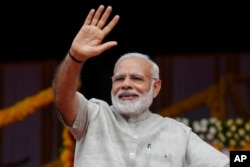India early on Saturday introduced its biggest tax reform in the 70 years since independence from British colonial rule.
The Goods and Services Tax (GST) replaces more than a dozen federal and state levies and unifying a $2 trillion economy and 1.3 billion people into one of the world's biggest common markets.
The measure is expected to make it easier to do business by simplifying the tax structure and ensuring greater compliance, boosting Prime Minister Narendra Modi's economic credentials before a planned re-election bid in 2019.
At a midnight ceremony in parliament's central hall Modi and President Pranab Mukherjee together launched the new tax by pressing a button.
"With GST, the dream of 'One India, Great India' will come true," Modi said.
For the first midnight ceremony in the central hall in two decades, Modi was joined by his cabinet colleagues, India's central bank chief, a former prime minister and major company executives including Ratan Tata.
The launch, however, was boycotted by several opposition parties including the Congress Party, which first proposed the tax reform before it fell from power three years ago.
Former Prime Minister Manmohan Singh - the architect of India's economic reforms - also gave it a miss.
Complex Structure
It has taken 14 years for the new sales tax to come into being. But horse trading to get recalcitrant Indian states on board has left Asia's third-largest economy with a complex tax structure.
In contrast to simpler sales taxes in other countries, India's GST has four rates and numerous exemptions.
The official schedule of rates runs to 213 pages and has undergone repeated changes, some taking place as late as on Friday evening.
Many businesses are nervous about how the changes will unfold, with smaller ones saying they will get hit by higher tax rates.
Adding to the complexity, businesses with pan-India operations face filing over 1,000 digital returns a year.
While higher tax rates for services and non-food items are expected to fuel price pressures, compliance is feared to be a major challenge in a country where many entrepreneurs are not computer literate and rely on handwritten ledgers.
"We have jumped into a river but don't know its depth," said A. Subba Rao, an executive director at power firm CLP India.
'One Tax, One Market, One Nation'
Poor implementation would deal a blow to an economy that is still recovering from Modi's decision late last year to outlaw 86 percent of the currency in circulation.
In a bid to mitigate the impact on the farm sector, the GST rates for tractors and fertilizer were slashed on Friday to 18 percent and 5 percent, respectively.
HSBC estimates the reform, despite its flaws, could add 0.4 percentage points to economic growth.
An end of tax arbitrage under the GST is estimated to save companies $14 billion in reduced logistics costs and efficiency gains.
As the GST is a value added tax, firms will have an incentive to comply in order to avail credit for taxes already paid. This should widen the tax net, shoring up public finances.
"The old India was economically fragmented," Finance Minister Arun Jaitley said. "The new India will create one tax, one market for one nation."









